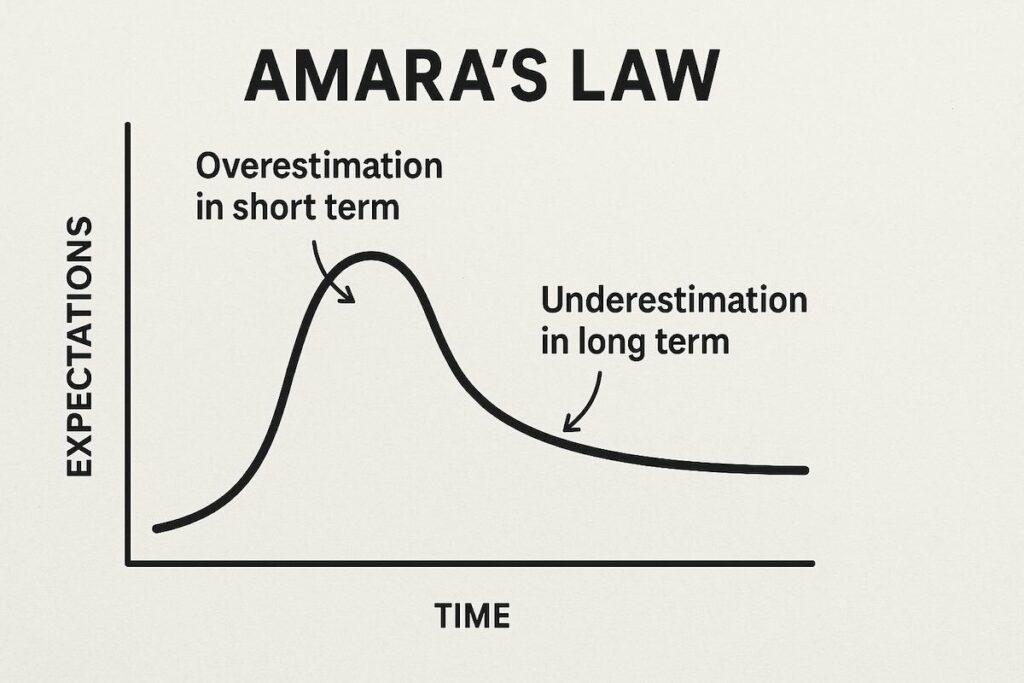In today’s world, predicting the future of tech is tough. We see big changes in things like artificial intelligence, blockchain, and virtual reality. The Amara’s Law mental model was created by futurist Roy Amara, and it shows why we often get it so wrong.
We tend to think new tech will change things fast, but it doesn’t always. And we often don’t see how big the impact will be in the long run. This idea is key for leaders, investors, and those who plan for the future.
What is Amara’s Law Mental Model?
Amara’s Law illustrated: The gap between our expectations and reality over time
Roy Amara, former president of the Institute for the Future, observed a consistent pattern in how humans perceive technological change. His insight became known as Amara’s Law: “We tend to overestimate the effect of a technology in the short run and underestimate the effect in the long run.”
This simple yet profound observation serves as a mental model – a thinking tool that helps us understand complex systems and make better decisions. When applied to technology adoption and innovation forecasting, Amara’s Law reveals why our predictions so often miss the mark.
The most profound technologies are those that disappear. They weave themselves into the fabric of everyday life until they are indistinguishable from it.
Understanding the Psychology Behind Amara’s Law
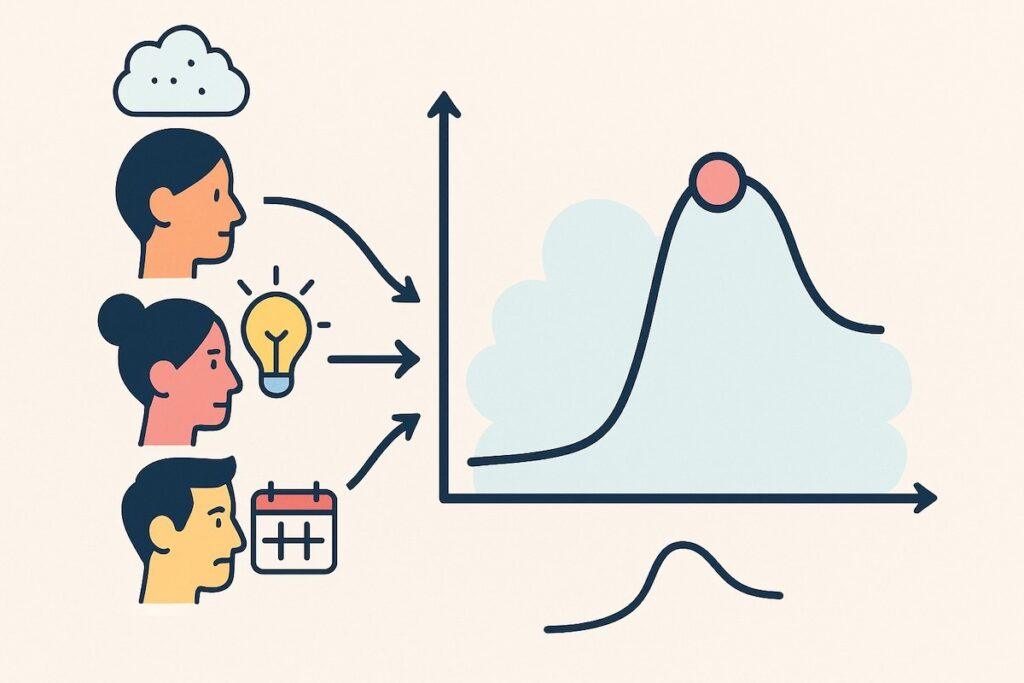
Amara’s Law is based on how our minds work. We love new things and quick results. This makes us fall for recency bias, hype cycles, and availability heuristics. These biases make us excited for the short term but overlook lasting changes.
Psychologists talk about the planning fallacy. It’s when we think things will be easier and faster than they are. This mistake is big in tech, leading to wasted resources and lost patience before real progress is seen. Knowing these biases helps us better understand tech.
How Amara’s Law Functions as a Mental Model
As a mental model, Amara’s Law provides a framework for understanding the adoption curve of new technologies. It helps us recognize our cognitive biases when evaluating innovation and makes us better decision-makers in technology-related fields, especially as experts analyze data to develop solutions that address challenges brought about by the pandemic.
The three phases of technological adoption according to Amara’s Law
Phase 1: Initial Hype
When new technologies emerge, they’re often accompanied by inflated expectations. Media coverage amplifies potential benefits while minimizing limitations. This creates unrealistic short-term expectations.
Phase 2: Disillusionment
When immediate transformative results don’t materialize, disappointment sets in. Interest wanes as the technology fails to meet unrealistic expectations, often leading to premature dismissal.
Phase 3: Long-term Impact
As the technology matures and integrates into existing systems, its true transformative potential emerges – often in ways not initially anticipated, creating greater impact than originally predicted.
Understanding these phases helps us maintain perspective when evaluating new technologies. Rather than being swayed by initial hype or subsequent disappointment, we can make more balanced assessments of potential long-term impact.
Amara’s Law Mental Model vs. Gartner Hype Cycle
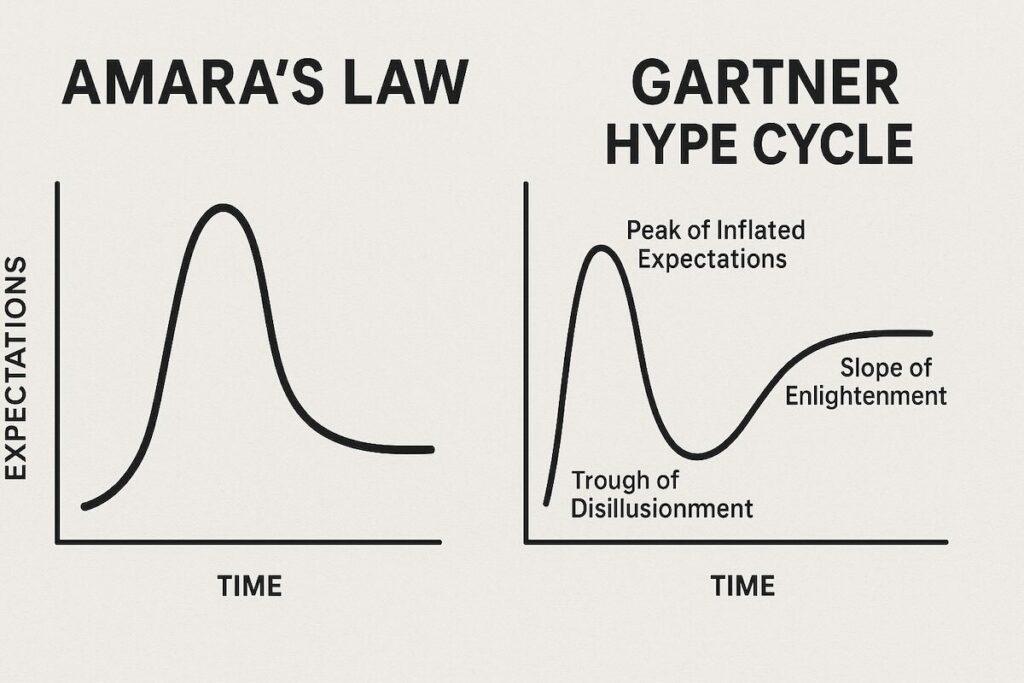
Amara’s Law shares similarities with the well-known Gartner Hype Cycle, but there are important distinctions. Both frameworks acknowledge the pattern of inflated expectations followed by disappointment, but they differ in their emphasis and application.
Comparing Amara’s Law with the Gartner Hype Cycle
| Aspect | Amara’s Law | Gartner Hype Cycle |
| Core Principle | Overestimation in short term, underestimation in long term | Five specific phases of technology adoption |
| Time Frame | Focuses on contrast between short and long term | Detailed progression through specific phases |
| Application | General principle applicable to all technologies | Specific methodology for tracking individual technologies |
| Complexity | Simple, intuitive mental model | More complex framework with detailed metrics |
| Primary Use | Decision-making and perspective maintenance | Technology investment timing and market analysis |
While the Gartner Hype Cycle provides a more detailed roadmap of technology adoption phases, Amara’s Law offers a simpler mental model that’s easier to apply across various contexts. Both frameworks complement each other and can be used together for more comprehensive technology assessment.
Amara’s Law Mental Model in Action: Real-World Examples
To truly understand the power of Amara’s Law as a mental model, let’s examine three contemporary technologies through its lens: artificial intelligence, virtual reality, and blockchain.
Artificial Intelligence (AI)
AI development through the lens of Amara’s Law
Short-term Overestimation
In the 1950s and 60s, AI pioneers predicted human-level artificial intelligence within a generation. Herbert Simon claimed in 1965 that “machines will be capable of doing any work a man can do” within 20 years. These predictions led to inflated expectations and eventual disappointment.
Long-term Underestimation
Few predicted how AI would transform everyday life through recommendation systems, voice assistants, and machine learning algorithms that now power countless applications. The subtle integration of AI into daily tools has created a more profound impact than the dramatic scenarios initially envisioned.
Virtual Reality (VR)
Virtual Reality’s journey through the Amara’s Law curve
Short-term Overestimation
In the 1990s, VR was heralded as the next computing platform that would revolutionize entertainment and work. Movies like “The Lawnmower Man” (1992) popularized the idea that immersive virtual worlds were just around the corner, creating unrealistic expectations.
Long-term Underestimation
After decades of development, VR is now finding practical applications beyond gaming in fields like medical training, architectural visualization, therapy, and remote collaboration. Its long-term impact on how we work, learn, and connect may be more profound than initially imagined.
Blockchain Technology
Blockchain’s evolution through the Amara’s Law perspective
Short-term Overestimation
The 2017 cryptocurrency boom led to predictions that blockchain would rapidly transform everything from banking to supply chains to voting systems. Many projects promised revolutionary change but failed to deliver immediate results, leading to the “crypto winter.”
Long-term Underestimation
Beyond the hype, blockchain is gradually finding practical applications in supply chain tracking, digital identity verification, and financial services. Its long-term impact on trust systems and decentralized applications may ultimately be more significant than early adopters predicted.
Amara’s Law Mental Model and Strategic Forecasting
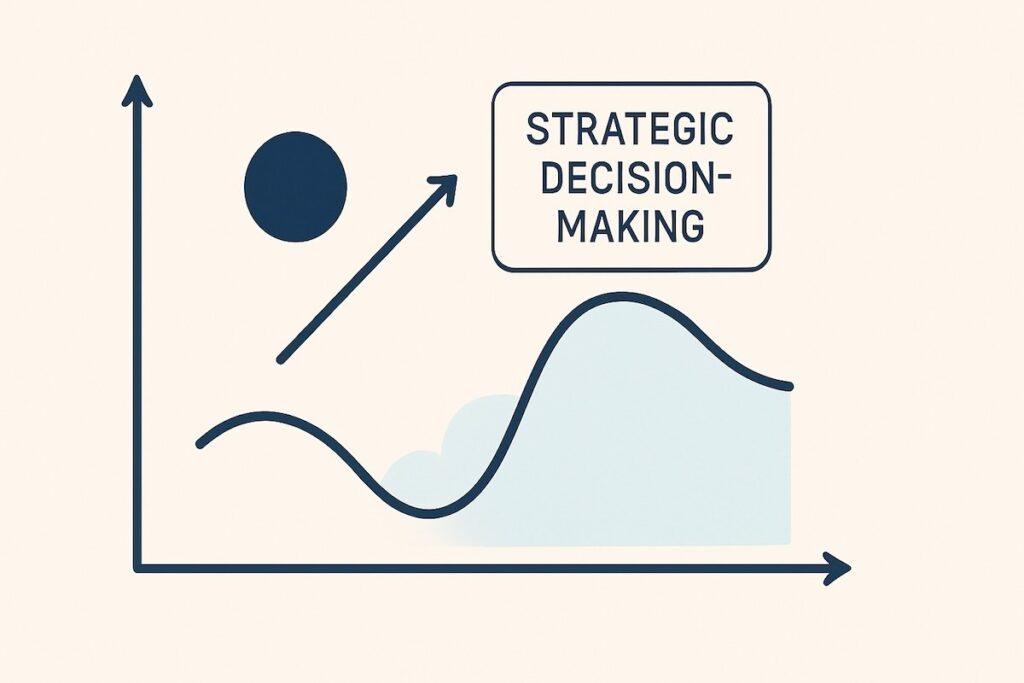
The Amara’s Law mental model is more than just a view on public opinion. It’s a tool for forecasting. It helps strategists in emerging tech markets, venture capital, and product development predict the true ROI timelines of new tech.
For instance, companies that looked beyond the initial VR excitement are now leading in areas like medical simulation and real estate tours. On the other hand, those who only invested based on early hype often left the market too early. The lesson is clear: Amara’s Law teaches us to be realistic about time. It helps us understand the slow start and growth of new technologies.
Applying the Amara’s Law Mental Model to Decision-Making
Amara’s Law isn’t just an interesting observation—it’s a practical mental model that can improve your technology-related decision-making. Here’s how to apply it:
Decision-making framework based on Amara’s Law
- Recognize the hype cycle. When a new technology emerges with bold promises, acknowledge that short-term expectations are likely inflated. This awareness helps maintain healthy skepticism.
- Look beyond immediate applications. Consider how a technology might evolve and integrate with existing systems over time. The most transformative impacts often come from unexpected applications. This second-order thinking uncovers the hidden consequences that might not be seen right away.
- Adopt a balanced investment approach. Avoid all-in or all-out decisions based on current hype. Instead, consider staged investments that allow for learning and adaptation as the technology matures.
- Focus on fundamentals. Evaluate technologies based on the fundamental problems they solve rather than their current popularity or media coverage.
- Consider integration challenges. Many technologies fail to deliver immediate impact due to integration difficulties with existing systems. Factor these challenges into your timeline expectations.
Amara’s Law Mental Model Case Study: Self-Driving Cars
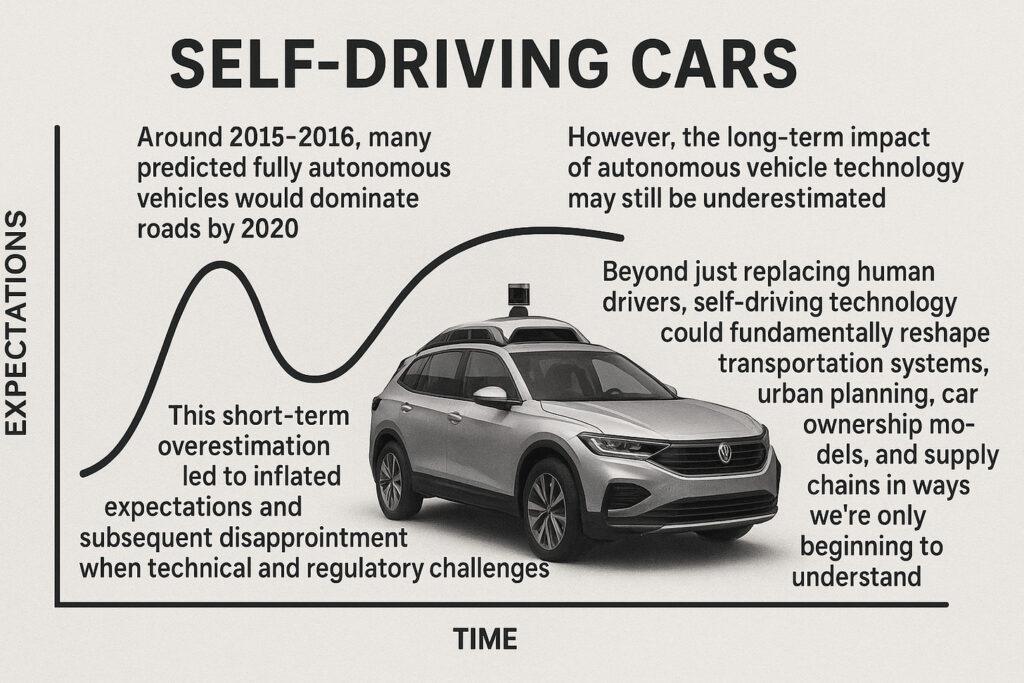
Self-driving car development through the lens of Amara’s Law
Self-driving cars provide a perfect illustration of Amara’s Law in action. Around 2015-2016, many predicted fully autonomous vehicles would dominate roads by 2020. This short-term overestimation led to inflated expectations and subsequent disappointment when technical and regulatory challenges proved more complex than anticipated.
However, the long-term impact of autonomous vehicle technology may still be underestimated. Beyond just replacing human drivers, self-driving technology could fundamentally reshape transportation systems, urban planning, car ownership models, and supply chains in ways we’re only beginning to understand.
Applying Amara’s Law to self-driving cars: Rather than focusing solely on when full autonomy will arrive, consider investing in the ecosystem and infrastructure that will enable and benefit from increasing vehicle autonomy over time.
Practical Applications of the Amara’s Law Mental Model
For Business Leaders
- Develop technology roadmaps that account for both short-term limitations and long-term potential
- Create staged investment strategies that allow for learning and adaptation
- Balance innovation initiatives with practical implementation considerations
- Communicate realistic timelines to stakeholders to manage expectations
For Investors
- Distinguish between speculative hype and fundamental value creation potential
- Consider longer investment horizons for truly transformative technologies
- Look for companies that demonstrate realistic understanding of adoption challenges
- Diversify investments across different stages of the technology adoption curve
Strategic investment approach based on Amara’s Law phases
For Consumers
- Approach “revolutionary” new products with healthy skepticism
- Consider waiting for second or third-generation products when adoption costs are high
- Focus on technologies that solve real problems rather than creating new ones
- Look beyond flashy features to long-term utility and integration potential
For Policy Makers
- Develop flexible regulatory frameworks that can evolve with technologies
- Balance innovation encouragement with appropriate safeguards
- Consider long-term societal impacts beyond immediate economic effects
- Invest in education and infrastructure that enables adaptation to technological change
Linking Amara’s Law with Diffusion of Innovation
Amara’s Law works well with Everett Rogers’ Diffusion of Innovation theory. Rogers talks about the adoption curve, from innovators to early adopters and laggards. Amara’s Law adds to this by explaining the emotional and perceptual cycle that affects each stage.
These theories together form a strong tool. One shows how adoption spreads, while the other explains why our judgments are often wrong. This mix is great for product marketers, startup founders, and policymakers. They need to understand both market trends and human biases.
Conclusion: Embracing the Wisdom of Amara’s Law
The Amara’s Law mental model reminds us that our view of innovation is often wrong. We look for big changes too soon and miss the slow, but important, shifts. This model helps leaders, investors, and analysts make better choices by avoiding risky bets and focusing on the future.
Amara’s Law is simple yet powerful. It applies to many areas like AI, clean energy, or blockchain. It tells us to look beyond today’s headlines and think about a technology’s full lifecycle impact.
When you’re considering a new tech idea, remember Amara’s Law. It offers a long-term view that can lead to smarter choices.
